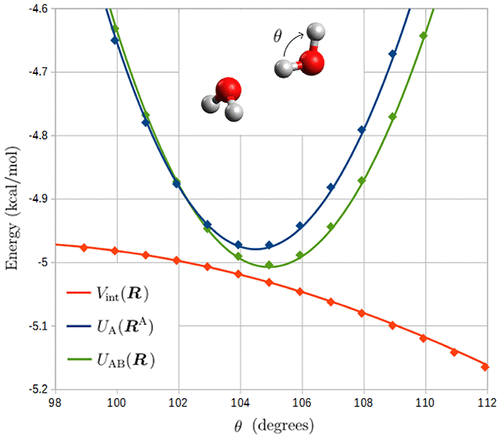当前位置:
X-MOL 学术
›
J. Chem. Theory Comput.
›
论文详情
Our official English website, www.x-mol.net, welcomes your
feedback! (Note: you will need to create a separate account there.)
Automatic Generation of Flexible-Monomer Intermolecular Potential Energy Surfaces
Journal of Chemical Theory and Computation ( IF 5.7 ) Pub Date : 2020-04-02 , DOI: 10.1021/acs.jctc.9b01241 Michael P. Metz 1 , Krzysztof Szalewicz 1
Journal of Chemical Theory and Computation ( IF 5.7 ) Pub Date : 2020-04-02 , DOI: 10.1021/acs.jctc.9b01241 Michael P. Metz 1 , Krzysztof Szalewicz 1
Affiliation

|
A method is developed for automatic generation of nonreactive intermolecular two-body potential energy surfaces (PESs) including intramonomer degrees of freedom. This method, called flex-autoPES, is an extension of the autoPES method developed earlier, which assumes rigid monomers. In both cases, the whole PES development proceeds without any human intervention. The functional form used is a sum of products of site–site functions (both atomic and off-atomic sites can be used). The leading terms with sites involving different monomers are of physically motivated form. The long-range part of a PES is computed from monomer properties without using any dimer information. The close-range part is fitted to dimer interaction energies computed using electronic structure methods. Virtually any method can be used in such calculations, but the use of symmetry-adapted perturbation theory provides a seamless connection to the long-range part of the PES. The performance of the flex-autoPES code was tested by developing a full-dimensional PES for the water dimer and PESs including only some soft intramonomer degrees of freedom for the ethylene glycol dimer and for the ethylene glycol–water dimer. In the case of the water dimer, the root-mean-square error (RMSE) of the PES from the data points with negative total energies is 0.03 kcal/mol, and we expect this PES to be more accurate than any previously published PES of this type. For the ethylene glycol dimer and the ethylene glycol–water dimers, the analogous RMSEs are 0.25 and 0.1 kcal/mol, respectively.
中文翻译:

自动生成柔性单体分子间势能面
开发了一种用于自动生成包括单体内自由度的非反应性分子间两体势能面(PES)的方法。这种称为flex-autoPES的方法是早期开发的autoPES方法的扩展,该方法假定使用刚性单体。在这两种情况下,整个PES的开发过程都无需人工干预。所使用的功能形式是站点间功能乘积的总和(可以使用原子站点和原子外站点)。具有涉及不同单体的位点的主要术语是出于物理动机的形式。PES的远距离部分是从单体性质计算而无需使用任何二聚体信息。近距离部分适合使用电子结构方法计算的二聚体相互作用能。实际上,任何方法都可以用于此类计算,但是使用对称自适应扰动理论可以无缝连接到PES的远程部分。通过开发用于水二聚体的全尺寸PES和仅包括乙二醇二聚体和乙二醇-水二聚体的某些软单体内自由度的PES,测试了flex-autoPES代码的性能。在水二聚体的情况下,来自具有总总能量为负的数据点的PES的均方根误差(RMSE)为0.03 kcal / mol,我们希望该PES比以前发布的任何PES更准确这种类型。对于乙二醇二聚物和乙二醇-水二聚物,类似的RMSE分别为0.25和0.1 kcal / mol。通过开发用于水二聚体的全尺寸PES和仅包括乙二醇二聚体和乙二醇-水二聚体的某些软单体内自由度的PES,测试了flex-autoPES代码的性能。在水二聚体的情况下,来自具有总总能量为负的数据点的PES的均方根误差(RMSE)为0.03 kcal / mol,我们希望该PES比以前发布的任何PES更准确这种类型。对于乙二醇二聚物和乙二醇-水二聚物,类似的RMSE分别为0.25和0.1 kcal / mol。通过开发用于水二聚体的全尺寸PES和仅包括乙二醇二聚体和乙二醇-水二聚体的某些软单体内自由度的PES,测试了flex-autoPES代码的性能。在水二聚体的情况下,来自具有总总能量为负的数据点的PES的均方根误差(RMSE)为0.03 kcal / mol,我们希望该PES比以前发布的任何PES更准确这种类型。对于乙二醇二聚物和乙二醇-水二聚物,类似的RMSE分别为0.25和0.1 kcal / mol。来自具有总总能量为负的数据点的PES的均方根误差(RMSE)为0.03 kcal / mol,我们希望该PES比任何以前发布的此类PES更为准确。对于乙二醇二聚物和乙二醇-水二聚物,类似的RMSE分别为0.25和0.1 kcal / mol。来自具有总总能量为负的数据点的PES的均方根误差(RMSE)为0.03 kcal / mol,我们希望该PES比任何以前发布的此类PES更为准确。对于乙二醇二聚物和乙二醇-水二聚物,类似的RMSE分别为0.25和0.1 kcal / mol。
更新日期:2020-04-24
中文翻译:

自动生成柔性单体分子间势能面
开发了一种用于自动生成包括单体内自由度的非反应性分子间两体势能面(PES)的方法。这种称为flex-autoPES的方法是早期开发的autoPES方法的扩展,该方法假定使用刚性单体。在这两种情况下,整个PES的开发过程都无需人工干预。所使用的功能形式是站点间功能乘积的总和(可以使用原子站点和原子外站点)。具有涉及不同单体的位点的主要术语是出于物理动机的形式。PES的远距离部分是从单体性质计算而无需使用任何二聚体信息。近距离部分适合使用电子结构方法计算的二聚体相互作用能。实际上,任何方法都可以用于此类计算,但是使用对称自适应扰动理论可以无缝连接到PES的远程部分。通过开发用于水二聚体的全尺寸PES和仅包括乙二醇二聚体和乙二醇-水二聚体的某些软单体内自由度的PES,测试了flex-autoPES代码的性能。在水二聚体的情况下,来自具有总总能量为负的数据点的PES的均方根误差(RMSE)为0.03 kcal / mol,我们希望该PES比以前发布的任何PES更准确这种类型。对于乙二醇二聚物和乙二醇-水二聚物,类似的RMSE分别为0.25和0.1 kcal / mol。通过开发用于水二聚体的全尺寸PES和仅包括乙二醇二聚体和乙二醇-水二聚体的某些软单体内自由度的PES,测试了flex-autoPES代码的性能。在水二聚体的情况下,来自具有总总能量为负的数据点的PES的均方根误差(RMSE)为0.03 kcal / mol,我们希望该PES比以前发布的任何PES更准确这种类型。对于乙二醇二聚物和乙二醇-水二聚物,类似的RMSE分别为0.25和0.1 kcal / mol。通过开发用于水二聚体的全尺寸PES和仅包括乙二醇二聚体和乙二醇-水二聚体的某些软单体内自由度的PES,测试了flex-autoPES代码的性能。在水二聚体的情况下,来自具有总总能量为负的数据点的PES的均方根误差(RMSE)为0.03 kcal / mol,我们希望该PES比以前发布的任何PES更准确这种类型。对于乙二醇二聚物和乙二醇-水二聚物,类似的RMSE分别为0.25和0.1 kcal / mol。来自具有总总能量为负的数据点的PES的均方根误差(RMSE)为0.03 kcal / mol,我们希望该PES比任何以前发布的此类PES更为准确。对于乙二醇二聚物和乙二醇-水二聚物,类似的RMSE分别为0.25和0.1 kcal / mol。来自具有总总能量为负的数据点的PES的均方根误差(RMSE)为0.03 kcal / mol,我们希望该PES比任何以前发布的此类PES更为准确。对于乙二醇二聚物和乙二醇-水二聚物,类似的RMSE分别为0.25和0.1 kcal / mol。











































 京公网安备 11010802027423号
京公网安备 11010802027423号